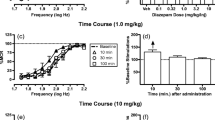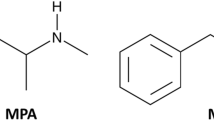Abstract
Drug abuse is one of the leading causes of loss of productivity, disease, and early death in the world. People typically start experimenting with drugs of abuse during adolescence, and about 20% of people who use drugs develop a substance abuse disorder. In general, drug use is more common in men than in women. However, when women use drugs, they are just as likely as men to develop a substance use disorder. Drugs of abuse induce euphoria, and the rewarding properties of drugs play an essential role in the early stages of drug use. After the development of dependence, cessation of drug use leads to somatic and affective withdrawal signs, which contributes to the maintenance of drug use. The intracranial self-stimulation (ICSS) method can be used to measure the acute rewarding properties of drugs and the dysphoria associated with drug withdrawal. One of the main advantages of the ICSS method is that it provides a quantitative measure of the rewarding aspects of drug use and the aversive aspects of withdrawal. The ICSS method can be used to identify sex differences in the rewarding and aversive aspects of drug use.
Access this chapter
Tax calculation will be finalised at checkout
Purchases are for personal use only
Similar content being viewed by others
References
UNODC (2018) World drug report 2018. United Nations Publication, Sales No. E.18.XI.9
Mounts NS, Steinberg L (1995) An ecological analysis of peer influence on adolescent grade point average and drug use. Dev Psychol 31(6):915
Abelson J, Treloar C, Crawford J, Kippax S, Van Beek I, Howard J (2006) Some characteristics of early-onset injection drug users prior to and at the time of their first injection. Addiction 101(4):548–555
Ritchie M, Roser M (2019) Drug use. OurWorldInData.org
Smart RG, Ogborne AC (2000) Drug use and drinking among students in 36 countries. Addict Behav 25(3):455–460
Becker JB, Hu M (2008) Sex differences in drug abuse. Front Neuroendocrinol 29(1):36–47
Becker JB, McClellan ML, Reed BG (2017) Sex differences, gender and addiction. J Neurosci Res 95(1–2):136–147
Gowing LR, Ali RL, Allsop S, Marsden J, Turf EE, West R, Witton J (2015) Global statistics on addictive behaviours: 2014 status report. Addiction 110(6):904–919
Sieminska A, Jassem E (2014) The many faces of tobacco use among women. Med Sci Monit 20:153
Reitsma MB, Fullman N, Ng M, Salama JS, Abajobir A, Abate KH, Abbafati C, Abera SF, Abraham B, Abyu GY (2017) Smoking prevalence and attributable disease burden in 195 countries and territories, 1990–2015: a systematic analysis from the Global Burden of Disease Study 2015. Lancet 389(10082):1885–1906
Thalheimer W, Cook S (2002) How to calculate effect sizes from published research: a simplified methodology. Work-Learning Research, p 1
WHO (2015) WHO report on the global tobacco epidemic, 2015: raising taxes on tobacco. WHO, Geneva
Gentzke AS, Creamer M, Cullen KA, Ambrose BK, Willis G, Jamal A, King BA (2019) Vital signs: tobacco product use among middle and high school students—United States, 2011–2018. Morb Mortal Wkly Rep 68(6):157
Cullen KA, Gentzke AS, Sawdey MD, Chang JT, Anic GM, Wang TW, Creamer MR, Jamal A, Ambrose BK, King BA (2019) e-Cigarette use among youth in the United States, 2019. JAMA 322:2095. https://doi.org/10.1001/jama.2019.18387
Leventhal AM, Strong DR, Kirkpatrick MG, Unger JB, Sussman S, Riggs NR, Stone MD, Khoddam R, Samet JM, Audrain-McGovern J (2015) Association of electronic cigarette use with initiation of combustible tobacco product smoking in early adolescence. JAMA 314(7):700–707
Hamilton HA, Ferrence R, Boak A, Schwartz R, Mann RE, O’Connor S, Adlaf EM (2014) Ever use of nicotine and nonnicotine electronic cigarettes among high school students in Ontario, Canada. Nicotine Tob Res 17(10):1212–1218
Morean ME, Krishnan-Sarin S, O’Malley SS (2018) Assessing nicotine dependence in adolescent e-cigarette users: the 4-item Patient-Reported Outcomes Measurement Information System (PROMIS) Nicotine Dependence Item Bank for electronic cigarettes. Drug Alcohol Depend 188:60–63
Olds J, Milner P (1954) Positive reinforcement produced by electrical stimulation of septal area and other regions of rat brain. J Comp Physiol Psychol 47(6):419–427
Olds J (1958) Self-stimulation of the brain: its use to study local effects of hunger, sex, and drugs. Science 127(3294):315–324
Der-Avakian A, Markou A (2012) The neurobiology of anhedonia and other reward-related deficits. Trends Neurosci 35(1):68–77
Carlezon WA Jr, Chartoff EH (2007) Intracranial self-stimulation (ICSS) in rodents to study the neurobiology of motivation. Nat Protoc 2(11):2987–2995. https://doi.org/10.1038/nprot.2007.441
Marcus R, Kornetsky C (1974) Negative and positive intracranial reinforcement tresholds: effects of morphine. Psychopharmacologia 38(1):1–13
Stein L, Ray OS (1959) Self-regulation of brain-stimulating current intensity in the rat. Science 130(3375):570–572
Bruijnzeel AW, Lewis B, Bajpai LK, Morey TE, Dennis DM, Gold M (2006) Severe deficit in brain reward function associated with fentanyl withdrawal in rats. Biol Psychiatry 59(5):477–480
Igari M, Alexander JC, Ji Y, Qi X, Papke RL, Bruijnzeel AW (2013) Varenicline and cytisine diminish the dysphoric-like state associated with spontaneous nicotine withdrawal in rats. Neuropsychopharmacology 39:455–465
Bruijnzeel AW (2012) Tobacco addiction and the dysregulation of brain stress systems. Neurosci Biobehav Rev 36:1418–1441
Bruijnzeel AW, Gold MS (2005) The role of corticotropin-releasing factor-like peptides in cannabis, nicotine, and alcohol dependence. Brain Res Rev 49(3):505–528
Foll BL, Goldberg SR (2009) Effects of nicotine in experimental animals and humans: an update on addictive properties. In: Henningfield JE, London ED, Pogun S (eds) Nicotine psychopharmacology. Springer, Berlin, pp 335–367. https://doi.org/10.1007/978-3-540-69248-5_12
Heishman SJ, Kleykamp BA, Singleton EG (2010) Meta-analysis of the acute effects of nicotine and smoking on human performance. Psychopharmacology 210(4):453–469
Benowitz NL (2009) Pharmacology of nicotine: addiction, smoking-induced disease, and therapeutics. Annu Rev Pharmacol Toxicol 49:57–71
Xue S, Behnood-Rod A, Wilson R, Wilks I, Tan S, Bruijnzeel AW (2018) Rewarding effects of nicotine in adolescent and adult male and female rats as measured using intracranial self-stimulation. Nicotine Tob Res 22:172–179. https://doi.org/10.1093/ntr/nty249
Lee AM, Calarco CA, McKee SA, Mineur YS, Picciotto MR (2019) Variability in nicotine conditioned place preference and stress-induced reinstatement in mice: effects of sex, initial chamber preference, and guanfacine. Genes Brain Behav 19:e12601
Lenoir M, Starosciak AK, Ledon J, Booth C, Zakharova E, Wade D, Vignoli B, Izenwasser S (2015) Sex differences in conditioned nicotine reward are age-specific. Pharmacol Biochem Behav 132:56–62. https://doi.org/10.1016/j.pbb.2015.02.019
Stratmann JA, Craft RM (1997) Intracranial self-stimulation in female and male rats: no sex differences using a rate-independent procedure. Drug Alcohol Depend 46(1):31–40
Legakis LP, Negus SS (2018) Repeated morphine produces sensitization to reward and tolerance to antiallodynia in male and female rats with chemotherapy-induced neuropathy. J Pharmacol Exp Ther 365(1):9–19
Lazenka M, Suyama J, Bauer C, Banks M, Negus S (2017) Sex differences in abuse-related neurochemical and behavioral effects of 3, 4-methylenedioxymethamphetamine (MDMA) in rats. Pharmacol Biochem Behav 152:52–60
Bain GT, Kornetsky C (1989) Ethanol oral self-administration and rewarding brain stimulation. Alcohol 6(6):499–503
Moolten M, Kornetsky C (1990) Oral self-administration of ethanol and not experimenter-administered ethanol facilitates rewarding electrical brain stimulation. Alcohol 7(3):221–225
Hughes JR, Gust SW, Skoog K, Keenan RM, Fenwick JW (1991) Symptoms of tobacco withdrawal. A replication and extension. Arch Gen Psychiatry 48(1):52–59
Hughes JR, Hatsukami D (1986) Signs and symptoms of tobacco withdrawal. Arch Gen Psychiatry 43(3):289–294
Wesnes K, Warburton DM (1983) Smoking, nicotine and human performance. Pharmacol Ther 21(2):189–208
Ep**-Jordan MP, Watkins SS, Koob GF, Markou A (1998) Dramatic decreases in brain reward function during nicotine withdrawal. Nature 393(6680):76–79
Hildebrand B, Nomikos G, Bondjers C, Nisell M, Svensson T (1997) Behavioral manifestations of the nicotine abstinence syndrome in the rat: peripheral versus central mechanisms. Psychopharmacology 129(4):348–356
Malin DH, Lake JR, Newlin-Maultsby P, Roberts LK, Lanier JG, Carter VA, Cunningham JS, Wilson OB (1992) Rodent model of nicotine abstinence syndrome. Pharmacol Biochem Behav 43(3):779–784
Malin DH, Lake JR, Carter VA, Cunningham JS, Hebert KM, Conrad DL, Wilson OB (1994) The nicotinic antagonist mecamylamine precipitates nicotine abstinence syndrome in the rat. Psychopharmacology 115(1–2):180–184
O’Dell LE, Bruijnzeel AW, Smith RT, Parsons LH, Merves ML, Goldberger BA, Richardson HN, Koob GF, Markou A (2006) Diminished nicotine withdrawal in adolescent rats: implications for vulnerability to addiction. Psychopharmacology 186(4):612–619
Bruijnzeel AW, Markou A (2004) Adaptations in cholinergic transmission in the ventral tegmental area associated with the affective signs of nicotine withdrawal in rats. Neuropharmacology 47(4):572–579
Bespalov A, Lebedev A, Panchenko G, Zvartau E (1999) Effects of abused drugs on thresholds and breaking points of intracranial self-stimulation in rats. Eur Neuropsychopharmacol 9(5):377–383
Nakahara D (2004) Influence of nicotine on brain reward systems: study of intracranial self-stimulation. Ann N Y Acad Sci 1025(1):489–490
Paterson NE (2009) The neuropharmacological substrates of nicotine reward: reinforcing versus reinforcement-enhancing effects of nicotine. Behav Pharmacol 20(3):211–225
Leith NJ, Barrett RJ (1976) Amphetamine and the reward system: evidence for tolerance and post-drug depression. Psychopharmacologia 46(1):19–25
Lin D, Koob GF, Markou A (1999) Differential effects of withdrawal from chronic amphetamine or fluoxetine administration on brain stimulation reward in the rat--interactions between the two drugs. Psychopharmacology 145(3):283–294
Markou A, Koob GF (1991) Postcocaine anhedonia. An animal model of cocaine withdrawal. Neuropsychopharmacology 4(1):17–26
Schulteis G, Markou A, Gold LH, Stinus L, Koob GF (1994) Relative sensitivity to naloxone of multiple indices of opiate withdrawal: a quantitative dose-response analysis. J Pharmacol Exp Ther 271(3):1391–1398
Schulteis G, Markou A, Cole M, Koob GF (1995) Decreased brain reward produced by ethanol withdrawal. Proc Natl Acad Sci U S A 92(13):5880–5884
Tan S, Xue S, Behnood-Rod A, Chellian R, Wilson R, Knight P, Panunzio S, Lyons H, Febo M, Bruijnzeel AW (2019) Sex differences in the reward deficit and somatic signs associated with precipitated nicotine withdrawal in rats. Neuropharmacology 160:107756
Rylkova D, Shah HP, Small E, Bruijnzeel AW (2009) Deficit in brain reward function and acute and protracted anxiety-like behavior after discontinuation of a chronic alcohol liquid diet in rats. Psychopharmacology 203(3):629–640
Henricks AM, Berger AL, Lugo JM, Baxter-Potter LN, Bieniasz KV, Petrie G, Sticht MA, Hill MN, McLaughlin RJ (2017) Sex-and hormone-dependent alterations in alcohol withdrawal-induced anxiety and corticolimbic endocannabinoid signaling. Neuropharmacology 124:121–133
Varlinskaya EI, Spear LP (2004) Acute ethanol withdrawal (hangover) and social behavior in adolescent and adult male and female Sprague-Dawley rats. Alcohol Clin Exp Res 28(1):40–50
Alele PE, Devaud LL (2007) Sex differences in steroid modulation of ethanol withdrawal in male and female rats. J Pharmacol Exp Ther 320(1):427–436
Liu J, Pan H, Gold MS, Derendorf H, Bruijnzeel AW (2008) Effects of fentanyl dose and exposure duration on the affective and somatic signs of fentanyl withdrawal in rats. Neuropharmacology 55(5):812–818
Cicero TJ, Nock B, Meyer ER (2002) Gender-linked differences in the expression of physical dependence in the rat. Pharmacol Biochem Behav 72(3):691–697
Paxinos G, Watson C (1998) The rat brain in stereotaxic coordinates, vol 4. Academic Press, San Diego, CA
Author information
Authors and Affiliations
Corresponding author
Editor information
Editors and Affiliations
Rights and permissions
Copyright information
© 2022 Springer Science+Business Media, LLC, part of Springer Nature
About this protocol
Cite this protocol
Chellian, R., Wilson, R., Behnood-Rod, A., Bruijnzeel, A.W. (2022). Influence of Sex on the Effects of Nicotine and Other Drugs of Abuse on Intracranial Self-Stimulation. In: Aguilar, M.A. (eds) Methods for Preclinical Research in Addiction. Neuromethods, vol 174. Humana, New York, NY. https://doi.org/10.1007/978-1-0716-1748-9_1
Download citation
DOI: https://doi.org/10.1007/978-1-0716-1748-9_1
Published:
Publisher Name: Humana, New York, NY
Print ISBN: 978-1-0716-1747-2
Online ISBN: 978-1-0716-1748-9
eBook Packages: Springer Protocols




